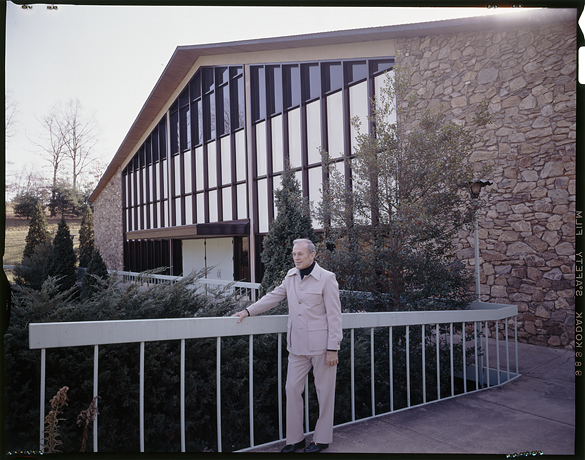Basketball was near and dear to Hugh Morton’s heart, and as we approach “March Madness” be forewarned: there are a few posts related to basketball in the offing. Today, A View to Hugh contributor Jack Hilliard takes a look at how the Justice Center at the University of North Carolina at Asheville got its name.

Last fall the Asheville City Council and the Buncombe County Board of Commissioners proclaimed Sunday, November 13, 2011 as “UNC Asheville Bulldog Day.” On that day, University of North Carolina at Chapel Hill head basketball coach Roy Williams, an Asheville native, took his Tar Heels to the “Land of the Sky” for a game with Eddie Biedenbach’s Bulldogs of the University of North Carolina at Asheville. It was the inaugural game for the 3000-seat Kimmel Arena, the Bulldogs’ new home. The Tar Heels won that game, but the Bulldogs have had a great season in their new facility, having won the Big South Conference regular season championship.
The road to the 2012 Final Four will pass through Kimmel Arena with the Southern Conference and the Big South Conference playing tournament games there. For the thirty-five seasons leading up to the 2011–2012 campaign, however, UNC-Asheville played its home games in the Charles Justice Sports, Health, and Physical Education Center—a 1100-seat facility called Justice Center (sometimes called Justice Gym) which sits just south of the new arena on the UNCA campus. For twelve seasons (1984-1995) this historic facility hosted the Southern Conference Tournament. The complex, built between 1959 and 1968 when the school was the Asheville-Biltmore College, includes a basketball court, classrooms and offices, swimming pool, dance studio, gymnastics area, tennis courts, a track, and soccer field.
⸑
On Monday, February 24th, 1975, UNCA trustee chairman G. Hoyle Blanton announced the dedication of the Justice Center at a dinner meeting of the board of trustees at the Great Smokies Hilton. The following Sunday, March 2nd, an editorial titled “An Honor for Choo Choo” in the Asheville-Citizens-Times explained why the trustees of the University of North Carolina at Asheville had voted to name its $1.75 million physical education and athletic complex for Charlie Justice:
Mention his name in almost any place in this country, and in some places outside of it, and a flood of warm memories are evoked. . . . UNCA, which correctly places academics above athletics, has honored a native son who managed to keep his perspective and still win.
I recall sitting at my desk at WFMY-TV in Greensboro in the spring of 1975 when I got a call from Ian MacBryde, WFMY’s Public Affairs Producer. He had gotten a call from Pete Gilpin, UNCA’s Director of Public Information. Gilpin wanted to know if we had any film of Charlie Justice playing for the Tar Heels that they might show at the dedication ceremony. MacBryde and I decided to produce a fifteen-minute mini-documentary for the occasion. Our piece became a part of the formal dedication of “The Charles Justice Sports, Health, and Physical Education Center” on November 28, 1975. The ceremony was held between first-round games of the 10th Annual Optimist Tip-Off Basketball Tournament.
Dr. William E. Highsmith, UNCA Chancellor, was master of ceremonies that evening and presented Justice with a framed photograph of the facility. Also taking part in the ceremony were Asheville Mayor Richard Wood, and Hendersonville City Commissioner and Justice’s UNC teammate Joe Wright. Representing the consolidated UNC trustees was another Tar Heel teammate Art Weiner. Rev. John McReadie Barr delivered the invocation. Barr was the former rector of St. James Episcopal Church in Hendersonville where Charlie and his wife Sarah attended church when Justice was in the oil business with Wright. Also on the program was Coach Ralph James, Justice’s high school coach at Lee Edwards High during the 1941 and 1942 seasons.
In his comments, Coach James said, “Charlie didn’t need much coaching. You just told him the general idea and he did it. In fact, he didn’t really need a coach. All he needed was someone to tape his ankles and pump up the ball.” Weiner congratulated Justice and said, “All of his teammates feel he deserves this honor. His records still stand and his contributions will never be surpassed.” Said Justice, “I often dreamed of being an All-America and playing for the University of North Carolina but I never thought it would come true. But it wasn’t all me. A lot of people made it possible for me to do some things on the football field. Those are the people who are really being honored here tonight.” Justice praised his teammates and coaches and then in true Justice form, he thanked his linemen who opened up those holes in the opposing lines. He then thanked his wife. “Without Sarah and the support of my family, this evening would not have been possible.”
During the week following the dedication ceremony, the Greensboro Daily News published Hugh Morton’s portrait of Justice standing in front of the building (seen above). The photo caption read, “Choo Choo and His Building.” The late Smith Barrier, Executive Sports Editor of the Daily News, commented on that March 2nd editorial saying, “An Asheville Citizen-Times editorial calls the dedication announcement ‘An Honor For Choo Choo.’ I would add an honor for UNCA.”

There is a new book out called “Justice for All! The History of the Justice Center,” by Marty Nicholson.
http://www.uncabulldogs.com/ViewArticle.dbml?DB_OEM_ID=19200&ATCLID=205376991
Justice Center will once again be center court for an important tournament game tomorrow. At noon on Saturday, March 3rd, the Wofford Terriers will take on the top-seeded Davidson Wildcats in the quarterfinals of the Southern Conference Women’s Basketball Tournament.
The game has been moved from Kimmel Arena so it does not interfere with the Big South Conference men’s championship game between UNCA and VMI.
Justice Gym was in the political spotlight earlier this month.
http://blogs2.citizen-times.com/jarrett/2012/10/02/biggest-celebrity-at-unca-biden-or-jordan/